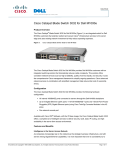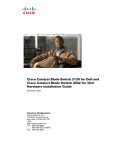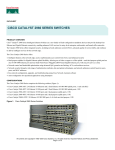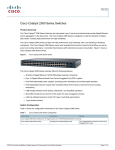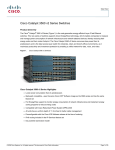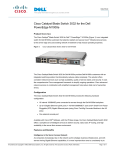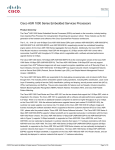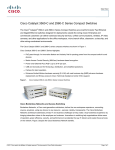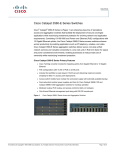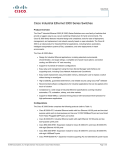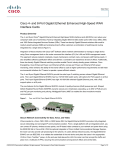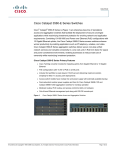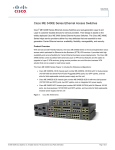Download DELL WS-CBS3130X-S network switch
Transcript
Data Sheet Cisco Catalyst Blade Switch 3130 for the Dell PowerEdge M1000e ® The Cisco Catalyst Blade Server 3130 represents the next-generation networking solution for ® ® blade server environments. Built on the market-leading Cisco hardware and Cisco IOS Software, the Cisco Catalyst Blade Switch 3130 (Figure 1) is engineered with unique technologies specifically designed to meet the rigors of blade server–based application infrastructure. Specifically, the switch is designed to deliver scaleable, high-performance, highly resilient connectivity while supporting ongoing IT initiatives to reduce server infrastructure complexity and total cost of ownership (TCO). Figure 1. Cisco Catalyst Blade Switch 3130 for the Dell™ PowerEdge™ M1000e Configurations The Cisco Catalyst Blade Switch 3130 for the Dell PowerEdge M1000e has two configurations and SKUs. One configuration allows customers to connect the switch to the existing network fabric using Gigabit Ethernet uplinks, and the other configuration allows customers to connect the switch to the existing network fabric using Gigabit and 10 Gigabit Ethernet uplinks. Configuration 1: Cisco Catalyst Blade Switch 3130G for Dell M1000e ● Supports up to 8 Gigabit Ethernet uplink ports: 4 10/100/1000BASE-T ports and 4 Small Form-Factor Pluggable (SFP) Gigabit Ethernet ports (using Cisco TwinGig Converter Modules in the X2 slots) Configuration 2: Cisco Catalyst Blade Switch 3130X for Dell M1000e ● Supports up to 4 10/100/1000BASE-T ports and 2 X2-based 10 Gigabit Ethernet ports Virtual Blade Switch (VBS) Technology With the Cisco Catalyst Blade Switch 3130, Cisco introduces a unique technology called the Virtual Blade Switch (VBS). This switch virtualization technology treats the interconnected physical switches within a rack as one logical switch (Figure 2). This innovation is the foundation of the switches’ capability to deliver increased performance and resilience while simplifying operations and management. The VBS delivers a number of specific advantages: ● By significantly simplifying data center design and operations, the VBS reduces infrastructure complexity, improves network resiliency, and increases the operational manageability of the blade-switching environment. All contents are Copyright © 1992–2008 Cisco Systems, Inc. All rights reserved. This document is Cisco Public Information. Page 1 of 13 Data Sheet ● By providing up to160 Gbps upstream, the VBS provides exceptional performance. In addition, the VBS can double the bandwidth available to a server. ● Because the VBS appears as a single node, both the Layer 2 and Layer 3 topologies are greatly simplified, increasing fabric stability and reducing convergence times after a topology change. The VBS offers several layers of link virtualization, which increases redundancy and available bandwidth. ● The VBS uses the same Cisco IOS Software interface, MIBs, and management tools as the rest of the Cisco Catalyst family, which simplifies operations and management, helping ensure consistent implementation and operation of end-to-end features such as quality of service (QoS). ● A number of VBS features reduce TCO. Link virtualization increases utilization and reduces potential port count. Similarly, the capability to mix-and-match 10 Gigabit Ethernet switches provides customers with a cost-effective migration path. In addition, the advanced operations and troubleshooting tools reduce operating expenses. Figure 2. Switches in a rack are treated as a single logical switch A primary advantage of the VBS architecture is the use of multiple layers of virtualization to reduce infrastructure complexity. Because the VBS appears as a single node, it simplifies the Layer 2 and 3 topologies, which allows the VBS to be managed as a single logical switch instead of as multiple physical switches. This same approach reduces overall link count because links can be shared to increase utilization, which can reduce the number of links actually needed. The operational simplification extends beyond the reduction of effective switch count through the use of automation. The VBS provides automated provisioning of new blades to provide true immediately active operation. Similarly, the VBS offers automated tools such as Cisco IOS Embedded Event Manager (EEM), Cisco Generic Online Diagnostics (GOLD), and Cisco VFrame Data Center (DC) support to simplify overall management. All contents are Copyright © 1992–2008 Cisco Systems, Inc. All rights reserved. This document is Cisco Public Information. Page 2 of 13 Data Sheet VBS allows the Cisco Catalyst Blade Switch 3130 to deliver increased levels of performance to the blade server environment. The VBS can deliver up to 160 Gbps out of the rack, accommodating even the most demanding applications in the data center. Furthermore, the VBS architecture allows dual active links from each blade server. Although the primary goal is to provide high availability, this feature essentially doubles the available bandwidth to the server during normal (nonfailure) operations. The VBS also provides a high-speed conduit for interserver traffic, which is especially important for emerging Web 2.0 applications that generate increased interserver communications. Because application availability is paramount, the Cisco Catalyst Blade Switch 3130 is designed with multiple layers of resiliency. VBS supports redundant active downlinks to the server, which both provides redundant pathways and eliminates any access delay related to active and passive failover. The VBS also supports redundant uplinks, which improves link resiliency. Note that the VBS can be protected from upstream switch failure by mapping the upstream links to different switches. Because the VBS operates as a single node, it leads to simpler Layer 2 and 3 topologies that are inherently more stable. The various link virtualization mechanisms offer an additional layer of protection, because a link failure will not necessarily cause a service-disrupting topology change. At the hardware level, the VBS offers full online insertion and removal (OIR), which allows switch modules to be added or removed without disrupting the fabric or affecting other switch modules. The Cisco Catalyst Blade Switch 3130 offers operational consistency with the rest of the industryleading Cisco Catalyst family of switches. The switch modules use the familiar Cisco IOS Software command-line interface (CLI), consistent MIBs, and management tools such as CiscoWorks solutions. This consistency eliminates additional training costs and increases operational efficiency because operations do not have to deal with multiple management domains. Furthermore, this consistency with the rest of the Cisco Catalyst family helps ensure that end-to-end network services such as QoS are consistently implemented across the network. The VBS is designed to deliver reduced TCO throughout its lifetime. Initially, the VBS can reduce infrastructure costs through switch and link-level virtualization. Because the VBS allows concurrent use of Gigabit Ethernet and 10 Gigabit Ethernet switch modules, customers can slowly migrate as business needs dictate. At the same time, the VBS offers operational savings. The consistent Cisco IOS Software interface results in simpler operation processes, reducing operating expenses. The automation and integration toolset improve efficiency and reduces time-to-resolution, further decreasing operating expenses. The Cisco Catalyst Blade Switch 3130 is another example of why so many companies choose Cisco to meet their switching requirements. The Cisco Catalyst Blade Switch 3130 combines Cisco Catalyst heritage with product innovation to meet the unique demands of today’s blade server environment. Cisco Catalyst Blade Switch 3130 Software The Cisco Catalyst Blade Switch 3130 ships with the IP Base feature set. The IP Base feature set includes advanced QoS, a suite of security features, rate-limiting, access control lists (ACLs), and basic static and Routing Information Protocol (RIP) routing capability. Customers can upgrade the software to either the IP Services or Advanced IP Services feature set. The IP Services feature set provides a richer set of enterprise-class features, including advanced hardware-based IP unicast and multicast routing: Enhanced Interior Gateway Routing Protocol (EIGRP), Open Shortest Path First (OSPF), Border Gateway Protocol (BGP), Protocol Independent Multicast (PIM), and so on. The Advanced IP Services feature set offers IPv6 routing. All contents are Copyright © 1992–2008 Cisco Systems, Inc. All rights reserved. This document is Cisco Public Information. Page 3 of 13 Data Sheet Customers can transparently upgrade the software feature set through Cisco IOS Software activation. Software activation authorizes and enables the Cisco IOS Software feature sets. A special file contained in the switch, called a license file, is examined by the Cisco IOS Software when the switch is powered on. Cisco IOS Software activates the appropriate feature set based on the license type. License types can be changed, or upgraded, to activate a different feature set. Features and Benefits Table 1 summarizes product features and benefits. Table 1. Features and Benefits Category Features and Benefits Ease of use and ease of deployment The VBS is self-managing and self-configuring. When switches are added or removed, the master switch automatically loads the Cisco IOS Software version running on the VBS to the new switch, loads the global configuration parameters, and updates all the routing tables to reflect changes. Upgrades are applied universally and simultaneously to all members of the VBS. Ease-of-use features include the following: ● Dynamic Host Configuration Protocol (DHCP) autoconfiguration of multiple switches through a boot server eases switch deployment. ● Master configuration management helps ensure that all switches are automatically upgraded when the master switch receives a new software version. Automatic software version checking and updating help ensure that all switch members in the VBS have the same software version. ● Autonegotiation on all ports automatically selects half- or full-duplex transmission mode to optimize bandwidth. ● Dynamic Trunking Protocol (DTP) facilitates dynamic trunk configuration across all switch ports. ® ● Port Aggregation Protocol (PAgP) automates the creation of Cisco Fast EtherChannel groups or Gigabit EtherChannel groups to link to another switch, router, or server. ● Link Aggregation Control Protocol (LACP) allows the creation of Ethernet channeling with devices that conform to IEEE 802.3ad. This feature is similar to Cisco EtherChannel technology and PAgP. The Cisco Catalyst Blade Switch 3130 now supports LACP channels to blade servers, thus doubling server bandwidth to the network. ● Automatic media-dependent interface crossover (MDIX) automatically adjusts transmit and receive pairs if an incorrect cable type (crossover or straight-through) is installed. All contents are Copyright © 1992–2008 Cisco Systems, Inc. All rights reserved. This document is Cisco Public Information. Page 4 of 13 Data Sheet Availability and Scalability Superior resiliency for higher server and application availability ● The VBS is highly resilient. Each switch can operate both as master controller and as forwarding processor. Each switch in the VBS can serve as a master, creating a 1:N availability scheme for network control. In the unlikely event of a single-unit failure, all other units continue to forward traffic and maintain operation. High-availability features include the following: ● Cross-switch EtherChannel provides the capability to configure Cisco EtherChannel technology across different members of the VBS for high resiliency. ● IEEE 802.1D Spanning Tree Protocol support for redundant backbone connections and loopfree networks simplifies network configuration and improves fault tolerance. ● Cisco UplinkFast and BackboneFast technologies help ensure quick failover recovery, enhancing overall network stability and reliability. ● IEEE 802.1s/w Rapid Spanning Tree Protocol (RSTP) and Multiple Spanning Tree Protocol (MSTP) provide rapid spanning-tree convergence independent of spanning-tree timers and also offer the benefit of Layer 2 load balancing and distributed processing. The VBS units behave as a single spanning-tree node. ● Per-VLAN Rapid Spanning Tree (PVRST+) allows rapid spanning-tree reconvergence on a per-VLAN spanning-tree basis, without requiring the implementation of spanning-tree instances. ● VLAN Trunking Protocol (VTP) pruning limits bandwidth consumption on VTP trunks by flooding broadcast traffic only on trunk links required to reach the destination devices. ● The trunk failover feature allows rapid failover to the redundant switch in the blade enclosure if all uplinks from the primary switch fail. When the uplinks fail, the switch shuts down the ports connected to the blade servers and lets network interface card (NIC) teaming software direct traffic to the redundant switch. This feature is also known as link-state tracking. ● Switch port autorecovery (Errdisable) automatically attempts to re-enable a link that is disabled because of a network error. ● Power and cooling resiliency are provided through redundant power and cooling capabilities from the blade enclosure. ● Flexlink provides link redundancy with convergence time of less than 100 milliseconds (ms). ● Cisco Hot Standby Router Protocol (HSRP) is supported to create redundant, fail-safe routing topologies. ● Unidirectional Link Detection Protocol (UDLD) and Aggressive UDLD allow unidirectional links caused by incorrect fiber-optic wiring or port faults to be detected and disabled on fiberoptic interfaces. ● Switch-port autorecovery (Errdisable) automatically attempts to reactivate a link that is disabled because of a network error. ● Per-port broadcast, multicast, and unicast storm control prevents faulty servers from degrading overall system performance. ● Internet Group Management Protocol (IGMP) snooping provides fast client joins and leaves of multicast streams and limits bandwidth-intensive video traffic to only the requestors. ● Multicast VLAN registration (MVR) continuously sends multicast streams in a multicast VLAN while isolating the streams from subscriber VLANs for bandwidth and security reasons. All contents are Copyright © 1992–2008 Cisco Systems, Inc. All rights reserved. This document is Cisco Public Information. Page 5 of 13 Data Sheet QoS Advanced QoS The VBS offers industry-leading mechanisms for marking, classification, and scheduling to deliver superior performance for data, voice, and video traffic, all at wire speed. Following are some of the QoS features supported: ● Wire-rate performance supports highly granular QoS functions (for example, granular rate limiting). ● Cross-switch QoS allows QoS to be configured across the entire VBS. ● IEEE 802.1p class of service (CoS) and differentiated services code point (DSCP) field classification is provided, using marking and reclassification on a per-packet basis by source and destination IP address, MAC address, or Layer 4 TCP or User Datagram Protocol (UDP) port number. ● Cisco control plane and data plane QoS ACLs on all ports help ensure proper marking on a per-packet basis. ● Four egress queues per port help enable differentiated management of up to four traffic types. ● Shaped Round Robin (SRR) scheduling helps ensure differential prioritization of packet flows by intelligently servicing the ingress queues and egress queues. ● Weighted Tail Drop (WTD) provides congestion avoidance at the ingress and egress queues before a disruption occurs. ● Strict priority queuing helps ensure that the highest-priority packets are serviced ahead of all other traffic. ● The committed information rate (CIR) function provides bandwidth in increments as low as 8 Kbps. ● Rate limiting is provided based on source and destination IP address, source and destination MAC address, Layer 4 TCP and UDP information, or any combination of these fields, using QoS ACLs (IP ACLs or MAC ACLs), class maps, and policy maps. ● Up to 64 aggregate or individual policers are available. All contents are Copyright © 1992–2008 Cisco Systems, Inc. All rights reserved. This document is Cisco Public Information. Page 6 of 13 Data Sheet Security Networkwide security features The VBS supports a comprehensive set of security features for connectivity and access control, including ACLs, authentication, port-level security, and identity-based network services with IEEE 802.1x and extensions. This set of comprehensive features not only helps prevent external attacks, but defends the network against “man-in-the-middle” attacks, a primary concern in today’s business environment. The switch also supports the Network Admission Control (NAC) security framework. Security features include the following: ● Dynamic Address Resolution Protocol (ARP) Inspection (DAI) helps ensure user integrity by preventing malicious users from exploiting the insecure nature of the ARP protocol. ● DHCP snooping prevents malicious users from spoofing a DHCP server and sending out bogus addresses. This feature is used by other primary security features to prevent a number of other attacks such as ARP poisoning. ● IP source guard prevents a malicious user from spoofing or taking over another user’s ● IP address by creating a binding table between the client’s IP and MAC address, port, and VLAN. ● Private VLANs restrict traffic between hosts in a common segment by segregating traffic at Layer 2, turning a broadcast segment into a nonbroadcast multi-access-like segment. ● Private VLAN Edge provides security and isolation between switch ports, which helps ensure that users cannot snoop on other users’ traffic. ● The unicast Reverse Path Forwarding (RPF) feature helps mitigate problems caused by the introduction of malformed or forged (spoofed) IP source addresses into a network by discarding IP packets that lack a verifiable IP source address. ● IEEE 802.1x enables dynamic, port-based security, providing user authentication. ● IEEE 802.1x with VLAN assignment allows a dynamic VLAN assignment for a specific user regardless of where the user is connected. ● IEEE 802.1x and port security are provided to authenticate the port and manage network access for all MAC addresses, including that of the client. ● IEEE 802.1x with an ACL assignment enables the use of specific identity-based security policies regardless of where the user is connected. ● IEEE 802.1x with guest VLAN allows guests without IEEE 802.1x clients to have limited network access on the guest VLAN. ● Web authentication for non–IEEE 802.1x clients allows non–IEEE 802.1x clients to use a Secure Sockets Layer (SSL) based browser for authentication. ● Cisco security VLAN ACLs on all VLANs prevent unauthorized data flows from being bridged within VLANs. ● Cisco standard and extended IP security router ACLs define security policies on routed interfaces for control plane and data plane traffic. IPv6 ACLs can be applied to filter ● IPv6 traffic. ● Port-based ACLs for Layer 2 interfaces allow security policies to be applied on individual switch ports. ● Secure Shell (SSH) Protocol, Kerberos, and Simple Network Management Protocol Version 3 (SNMPv3) provide network security by encrypting administrator traffic during Telnet and SNMP sessions. SSH, Kerberos, and the cryptographic version of SNMPv3 require a special cryptographic software image because of U.S. export restrictions. ● Bidirectional data support on the Switched Port Analyzer (SPAN) port allows the Cisco Intrusion Detection System (IDS) to take action when an intruder is detected. ● TACACS+ and RADIUS authentication facilitates centralized control of the switch and restricts unauthorized users from altering the configuration. ● MAC address notification allows administrators to be notified of users added to or removed from the network. ● Port security secures the access to an access or trunk port based on the MAC address. ● Multilevel security on console access prevents unauthorized users from altering the switch configuration. ● Bridge protocol data unit (BPDU) guard shuts down Spanning Tree PortFast-enabled interfaces when BPDUs are received to avoid accidental topology loops. ● Spanning Tree Root Guard (STRG) prevents edge devices not in the network administrator’s control from becoming Spanning Tree Protocol root nodes. ● IGMP filtering provides multicast authentication by filtering out nonsubscribers and limits the number of concurrent multicast streams available per port. ● Dynamic VLAN assignment is supported through implementation of VLAN membership policy server client capability to provide flexibility in assigning ports to VLANs. Dynamic VLAN facilitates the fast assignment of IP addresses. All contents are Copyright © 1992–2008 Cisco Systems, Inc. All rights reserved. This document is Cisco Public Information. Page 7 of 13 Data Sheet High-Performance IP Routing IP Routing Features ● The VBS delivers extremely high-performance IP routing. IP routing features include: ● Basic IP unicast routing protocols (Static and RIPv1 and v2) are supported for small-network routing applications. ● Advanced IP unicast routing protocols (OSPF, EIGRP, and BGPv4) are supported for load balancing and construction of scalable LANs. The IP Services feature set is required. ● IPv6 routing (RIP next generation [RIPng] and OSPFv3) is supported in hardware for maximum performance. The Advanced IP Services feature set is required for IPv6 routing. ● Equal-cost routing facilitates Layer 3 load balancing and redundancy across the stack. ● Policy-based routing (PBR) allows superior control by facilitating flow redirection regardless of the routing protocol configured. The IP Services feature set is required. ● HSRP provides dynamic load balancing and failover for routed links. Up to 32 HSRP links are supported per unit or VBS. ● PIM for IP multicast routing is supported, including PIM sparse mode (PIM-SM), PIM dense mode (PIM-DM), and PIM sparse-dense mode. The IP Services feature set is required. ● Distance Vector Multicast Routing Protocol (DVMRP) tunneling interconnects two multicastenabled networks across nonmulticast networks. The IP Services feature set is required. ● Fallback bridging forwards non-IP traffic between two or more VLANs. The IP Services feature set is required. Manageability Management features The VBS is managed as a single object and has a single IP address. The primary management and control features include the following: ● Cisco IOS Software CLI support provides a common user interface and command set with all Cisco routers and Cisco Catalyst desktop switches. ● Switching database manager templates for access, routing, and VLAN deployment allow the administrator to easily maximize memory allocation to the desired features based on deployment-specific requirements. ● Cisco GOLD checks the health of hardware components and verifies proper operation of the system data and control plane at run time and boot time. ● Cisco IOS EEM allows customers to set up trigger points based on certain events to automatically take actions, thus automating network management ● VPN routing and forwarding (VRF) lite enables a service provider to support two or more VPNs with overlapping IP addresses. ● Local Proxy ARP works in conjunction with Private VLAN Edge to minimize broadcasts and maximize available bandwidth. ● VLAN1 minimization allows VLAN1 to be disabled on any individual VLAN trunk. ● Smart Multicast, with Cisco VBS technology, allows the Cisco Catalyst Blade Switch 3130 to offer greater efficiency and support for more multicast data streams such as video by putting each data packet onto the backplane only once. ● IGMP snooping for IPv4 and IPv6 Multicast Listener Discovery (MLD) Versions 1 and 2 snooping provide fast client joins and leaves of multicast streams and limit bandwidthintensive video traffic to only the requestors. ● Multicast VLAN registration (MVR) continuously sends multicast streams in a multicast VLAN while isolating the streams from subscriber VLANs for bandwidth and security reasons. ● Per-port broadcast, multicast, and unicast storm control prevents faulty end stations from degrading overall systems performance. ● Cisco VLAN Trunking Protocol (VTP) supports dynamic VLANs and dynamic trunk configuration across all switches. ● Remote SPAN (RSPAN) allows administrators to remotely monitor ports in a Layer 2 switch network from any other switch in the same network. ● For enhanced traffic management, monitoring, and analysis, the embedded remote monitoring (RMON) software agent supports four RMON groups (history, statistics, alarms, and events). ● Layer 2 traceroute eases troubleshooting by identifying the physical path that a packet takes from source to destination. ● Trivial File Transfer Protocol (TFTP) reduces the cost of administering software upgrades by enabling downloading from a centralized location. ● Network Timing Protocol (NTP) provides an accurate and consistent timestamp to all intranet switches. ● Multifunction LEDs per port show port status. ● Jumbo frames (9216 bytes) are available for advanced data and video applications requiring very large frames. ● SNMP v1, v2c, and v3 and Telnet interface support deliver comprehensive in-band management, and a CLI-based management console provides detailed out-of-band management. ● Cisco Discovery Protocol Versions 1 and 2 enable a network-management station for automatic switch discovery. All contents are Copyright © 1992–2008 Cisco Systems, Inc. All rights reserved. This document is Cisco Public Information. Page 8 of 13 Data Sheet Cisco Device Manager Cisco Network Assistant ● Cisco Device Manager simplifies initial configuration of a switch through a Web browser. ● The Web interface enables less-skilled personnel to quickly and simply set up switches, thereby reducing the cost of deployment. A PC-based network management application designed for server administrators in small to medium-sized data centers, Cisco Network Assistant offers centralized network management and configuration capabilities. This application also features an intuitive GUI where users can easily apply common services across Cisco switches and routers, such as the following: ● Configuration management ● Troubleshooting advice ● Inventory reports ● Event notification ● Network security settings ● Password synchronization ● Drag-and-drop Cisco IOS Software upgrades ● Secure wireless For detailed information about Cisco Network Assistant, visit: http://www.cisco.com/go/cna. CiscoWorks LAN Management Solution (LMS) CiscoWorks LMS is a suite of powerful management tools that simplify the configuration, administration, monitoring, and troubleshooting of Cisco networks. It integrates these capabilities into a world-class solution for improving the accuracy and efficiency of operations staff, while increasing the overall availability of the network. CiscoWorks LMS supports more than 400 device types, including the Cisco Catalyst Blade Switch 3130, and it provides the following benefits: ● Network discovery, topology views, end-station tracking, and VLAN management ● Real-time network fault analysis with easy-to-deploy device-specific best-practice templates ● Hardware and software inventory management, centralized configuration tools, and syslog monitoring ● Network response time and availability monitoring and tracking ● Real-time device, link, and port traffic management, analysis, and reporting For detailed information about CiscoWorks LMS, visit: http://www.cisco.com/en/US/products/sw/cscowork/ps2425/index.html. Product Specifications Table 2 lists hardware specifications, Table 3 lists management and standards support, and Table 4 lists safety and compliance information. Table 2. Description Performance Hardware Specifications Specification ● Up to 128-Gbps switching fabric ● Forwarding rate based on 64-byte packets; up to 59.2 million packets per second (mpps) ● 256 MB double-data-rate (DDR) synchronous dynamic RAM (SDRAM) and 64 MB Flash memory ● Configurable maximum transmission units (MTUs) of up to 9018 bytes (jumbo frames) ● MAC, routing, security, and QoS scalability numbers depend on the type of template used in the switch: Default Template Access Template VLAN Template Routing Template MAC address 6K 4K 12K 3K IGMP groups and multicast routes 1K 1K 1K 1K Total unicast routes 8K 6K 0 11K Directly connected hosts 6K 4K 0 3K Indirect routes 2K 2K 0 8K Security ACEs (access control entries) 1K 2K 1K 1K All contents are Copyright © 1992–2008 Cisco Systems, Inc. All rights reserved. This document is Cisco Public Information. Page 9 of 13 Data Sheet Connectors and cabling QoS ACEs (access control entries) 0.5K 0.5K 0.5K 0.5K PBR ACEs (access control entries) 0 0.5K 0 0.5K SKU 1: Cisco Catalyst Blade Switch 3130G ● Supports up to 8 Gigabit Ethernet uplink ports: 4 10/100/1000BASE-T ports and 4 SFPbased Gigabit ports (using Cisco TwinGig Converter Modules in the X2 slots) SKU 2: Cisco Catalyst Blade Switch 3130X ● Supports up to 4 10/100/1000BASE-T ports and 2 X2 based 10 Gigabit ports ● SFP and X2 cage supports only SFP and X2 modules from Cisco Common on both SKUs ● 4 external 10/100/1000BASE-T ports ● Management console port: RJ-45-to-DB9 cable for PC connections ● 2 high-speed stack connectors Power consumption 12V at 6.25A (75W) (max) Indicators Total of 19 LEDs on the faceplate: ● 12 LEDs for uplink port status ● 5 switch-status LEDs ● 2 Dell-specific LEDs Dimensions (L x W x H) 24.8 cm x 2.9 cm x 23.1 cm Weight Approximately 4.0 lb Environmental ranges ● Operating temperature: 0 to 40°C ● Storage temperature: –25 to 70°C ● Operating relative humidity: 10 to 85% noncondensing ● Storage relative humidity: 5 to 95% noncondensing Predicted mean time between failure (MTBF) Table 3. Description MIB support Approximately 390,000 hours Management and Standards Support Specification ● BRIDGE-MIB ● CISCO-CDP-MIB ● CISCO-VTP-MIB ● ENTITY-MIB ● CISCO-CLUSTER-MIB ● CISCO-CONFIG-MAN-MIB ● ETHERLIKE-MIB ● IF-MIB ● CISCO-ENTITY-FRU-CONTROL-MIB ● CISCO-ENVMON-MIB ● IGMP-MIB ● IPMROUTE-MIB ● CISCO-FLASH-MIB ● CISCO-FTP-CLIENT-MIB ● OLD-CISCO-CHASSIS-MIB ● OLD-CISCO-FLASH-MIB ● CISCO-HSRP-MIB ● CISCO-HSRP-EXT-MIB ● OLD-CISCO-INTERFACES-MIB ● OLD-CISCO-IP-MIB ● CISCO-IGMP-FILTER-MIB ● CISCO-IMAGE-MIB ● OLD-CISCO-SYS-MIB ● OLD-CISCO-TCP-MIB ● CISCO-IP-STAT-MIB ● CISCO-L2L3-INTERFACE-CONFIG-MIB ● OLD-CISCO-TS-MIB ● OSPF-MIB (RFC 1253) ● CISCO-POE-EXTENSIONS-MIB ● CISCO-MAC-NOTIFICATION-MIB ● PIM-MIB ● RFC1213-MIB ● CISCO-MEMORY-POOL-MIB ● CISCO-PAGP-MIB ● RFC1253-MIB ● RMON-MIB ● CISCO-PING-MIB ● CISCO-PROCESS-MIB ● RMON2-MIB ● SNMP-FRAMEWORK-MIB ● CISCO-RTTMON-MIB ● CISCO-STP-EXTENSIONS-MIB ● SNMP-MPD-MIB ● SNMP-NOTIFICATION-MIB ● CISCO-SYSLOG-MIB ● CISCO-TCP-MIB ● SNMP-TARGET-MIB ● SNMPv2-MIB ● CISCO-VLAN-IFTABLE-RELATIONSHIPMIB ● CISCO-VLAN-MEMBERSHIP-MIB ● TCP-MIB ● UDP-MIB All contents are Copyright © 1992–2008 Cisco Systems, Inc. All rights reserved. This document is Cisco Public Information. Page 10 of 13 Data Sheet ● IEEE 802.1s ● IEEE 802.1w Standards ● IEEE 802.1x ● IEEE 802.3ad ● IEEE 802.3x full duplex on 10BASE-T, 100BASE-TX, and 1000BASE-T ports ● IEEE 802.1D Spanning Tree Protocol ● IEEE 802.1p CoS Prioritization ● IEEE 802.1Q VLAN ● IEEE 802.3 10BASE-T specification ● IEEE 802.3u 100BASE-TX specification ● IEEE 802.3ab 1000BASE-T specification ● IEEE 802.3z 1000BASE-X specification ● 1000BASE-SX ● 1000BASE-LX/LH ● 10GBASE-SR ● 10GBASE-LRM ● 10GBASE-CX4 ● RMON I and II standards ● SNMPv1, SNMPv2c, and SNMPv3 Table 4. Safety and Compliance Description Specification Safety certifications ● UL/CUL Recognition to UL/CSA 60950-1 ● TUV Bauart to EN 60950-1 ● CB report and certificate to IEC 60950-1 with all country deviations ● CE Marking ● FCC Part 15 Class A ● EN 55022 Class A (CISPR22 Class A) Electromagnetic compatibility certifications ● EN55024 (CISPR24) ● VCCI Class A ● AS/NZS CISPR22 Class A ● MIC ● China EMC requirements ● GOST Telecommunications CLEI code Warranty 90 days Service and Support Cisco is committed to minimizing TCO and offers technical support services to help ensure that Cisco products operate efficiently, remain highly available, and benefit from the most up-to-date system software. Table 5 describes service and support that is available directly from Cisco and through resellers. Table 5. Service and Support Technical Support Service Cisco SMARTnet ® Features ● Access to Cisco IOS Software updates ● Web access to technical support tools and repositories ● 24-hour telephone support through the Cisco Technical Assistance Center (TAC) ● Advance replacement of hardware Benefits ● Minimizes network downtime through reliable day-to-day support and prompt resolution of critical network issues ● Lowers TCO by using Cisco networking expertise and knowledge ● Protects your network investment through Cisco IOS Software updates that provide patches and new functions All contents are Copyright © 1992–2008 Cisco Systems, Inc. All rights reserved. This document is Cisco Public Information. Page 11 of 13 Data Sheet Ordering Information Table 6 lists ordering information. Table 6. Ordering Information Part Number Description Switches WS-CBS3130G-S Cisco Catalyst Blade Switch 3130G for Dell M1000e with IP Base WS-CBS3130X-S Cisco Catalyst Blade Switch 3130X for Dell M1000e with IP Base Upgrade Licenses 3130-IPS-LIC Software Upgrade License for Cisco Catalyst Blade Switch 3130 to IP Services 3130-AISK9-LIC Software Upgrade License for Cisco Catalyst Blade Switch 3130 to Adv IP Services SFP Modules GLC-LH-SM= Gigabit Ethernet SFP, LC connector, long-wavelength / long-haul transceiver (single mode) GLC-T= Gigabit Ethernet SFP, RJ45 based Copper GLC-SX-MM= Gigabit Ethernet SFP, LC connector, short-wavelength transceiver (multimode) Cisco TwinGig Converter Module CVR-X2SFP TwinGig Converter Module X2 Modules X2-10GB-CX4= 10GBASE-CX4 X2 Module X2-10GB-SR= 10GBASE-SR X2 Module X2-10GB-LRM= 10GBASE-LRM X2 Module Cisco SMARTnet Options CON-SNT-CBS3130G Cisco SMARTnet with 8x5 next business day (NBD) hardware advance replacement CON-SNTE-CBS3130G Cisco SMARTnet with 8x5 4-hour hardware advance replacement CON-SNTP-CBS3130G Cisco SMARTnet with 24x7 4-hour hardware advance replacement CON-S2P-CBS3130G Cisco SMARTnet with 24x7 2-hour hardware advance replacement CON-SNT-CBS3130X Cisco SMARTnet with 8x5 next business day (NBD) hardware advance replacement CON-SNTE-CBS3130X Cisco SMARTnet with 8x5 4-hour hardware advance replacement CON-SNTP-CBS3130X Cisco SMARTnet with 24x7 4-hour hardware advance replacement CON-S2P-CBS3130X Cisco SMARTnet with 24x7 2-hour hardware advance replacement For More Information For more information about Cisco products, contact: ● United States and Canada: (toll free) 800 553-6387 ● Europe: 32 2 778 4242 ● Australia: 612 9935 4107 ● Other: 408 526-7209 ● http://www.cisco.com For more information about the Dell M1000e, contact: http://www.dell.com. Dell has tested and certified the Cisco 3032, 3130G, and 3130X switches for use in the Dell PowerEdge M1000e. All contents are Copyright © 1992–2008 Cisco Systems, Inc. All rights reserved. This document is Cisco Public Information. Page 12 of 13 Data Sheet Printed in USA All contents are Copyright © 1992–2008 Cisco Systems, Inc. All rights reserved. This document is Cisco Public Information. C78-439355-00 01/08 Page 13 of 13













